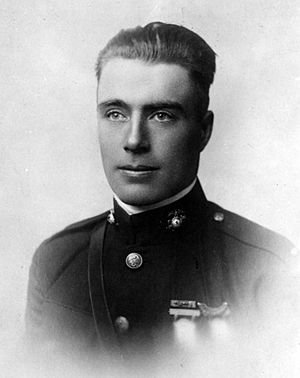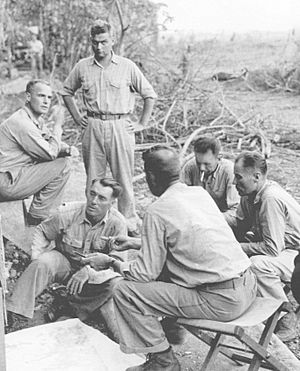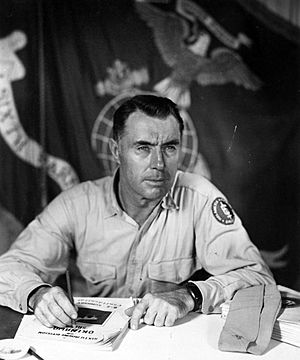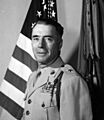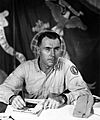William J. Whaling facts for kids
Quick facts for kids
William John Whaling
|
|
|---|---|
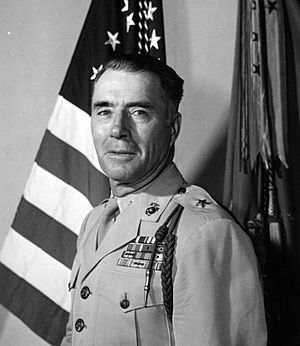
Whaling as Brigadier General, USMC
|
|
| Nickname(s) | "Wild Bill" |
| Born | February 26, 1894 St. Cloud, Minnesota |
| Died | November 20, 1989 (aged 95) Lyons, New Jersey |
| Place of Burial | |
| Allegiance | United States of America |
| Service/ |
|
| Years of service | 1917–1954 |
| Rank | |
| Service number | 0-1049 |
| Commands held | MCRD San Diego ADC of 1st Marine Division 1st Marine Regiment 29th Marine Regiment |
| Battles/wars | World War I
Nicaraguan Campaign
|
| Awards | Navy Cross Distinguished Service Medal Silver Star Legion of Merit (2) Bronze Star Medal Air Medal Purple Heart (2) |
William John Whaling (February 26, 1894 – November 20, 1989) was a very brave and important general in the United States Marine Corps. He was also super good at fighting in jungles during World War II in the Pacific. Whaling also competed as a sport shooter in the 1924 Summer Olympics. He came in 12th place in a pistol shooting contest.
He started his Marine Corps career as a regular soldier. He became an officer during World War I. Whaling stayed in the Marines and led groups of soldiers in big battles. These included Guadalcanal, Cape Gloucester, and Okinawa. For his bravery, he won the Navy Cross. During the Korean War, he was an assistant leader for a large group of soldiers. Later, he became the main leader at a Marine training base in San Diego.
Contents
Early Military Career
William J. Whaling was born on February 26, 1894, in St. Cloud, Minnesota. His parents were from Canada. He was a great athlete and finished high school. A baseball team, the St. Louis Browns, even wanted him to play for them.
His baseball career stopped when the U.S. joined World War I. He joined the Marine Corps in May 1917. Whaling completed basic training at Parris Island. Then, he joined a new group called the 1st Battalion, 6th Marines. After months of training, he sailed to France.
The 6th Marine Regiment was sent to fight in the trenches in March 1918. Whaling took part in the Battle of Belleau Wood in June that year. He was hurt by gas during this battle. He stayed in the hospital for two months. In August 1918, he became a second lieutenant (a type of officer).
Whaling then joined the main office of the 6th Marine Regiment. He fought in the Battle of Saint-Mihiel in September 1918. He showed great bravery in a fight near Thiaucourt. For this, he won a Silver Star award.
After the war ended, Whaling helped with the Allied forces taking control of Rhineland, Germany. There, he became friends with Gerald C. Thomas, who would later become a general. While in Germany, he also coached the 6th Marine Regiment's baseball team. He also won a gold medal in a pistol shooting contest in 1919. He returned to the U.S. in June 1919. He then joined the regular Marine Corps, keeping his officer rank.
Between the World Wars
After returning to the U.S., Whaling was sent to the Marine barracks in Portsmouth Naval Shipyard, Maine. He became a member of the National Pistol Team. He was promoted to first lieutenant on June 4, 1920. On March 31, 1921, he joined the regular Marine Corps. He was then assigned to the ship USS Tacoma. Whaling spent four months at sea. He sailed to Latin America and the Caribbean during times of trouble.
In April 1922, he was sent to Quantico, Virginia. There, he again served on the National Pistol Team. In December that year, Whaling joined the battleship USS Maryland. He took part in naval exercises near the Panama Canal Zone. He served on the Maryland until June 1923. Then, he went to Parris Island, South Carolina. He continued to be active in the Marine Corps Pistol and Rifle Team.
He quickly became known as a great shooter. He represented the U.S. at the 1924 Summer Olympics in Paris, France. He finished 12th in the 25-meter rapid fire pistol competition.
In October 1924, Whaling moved to the West Coast. He joined the headquarters of the Department of the Pacific in San Francisco. In December, he went to China for duty. Whaling was with the American Legation in Peking until December 1926.
After returning to the U.S., Whaling went to Quantico, Virginia. He took a course on base defense weapons. He finished in June 1927. The next March, he was sent to Nicaragua. He was part of the 2nd Brigade of Marines. Whaling went on many patrols in the jungle. He fought against bandits led by Augusto César Sandino. He returned to the U.S. in May 1929 for a new job.
Because he was an expert shooter, Whaling was put in charge of the Marine Corps Rifle and Pistol Team at Quantico. He also led the team. He was promoted to captain on December 1, 1930. Then, he was sent to Haiti. He worked as an instructor for the Garde d'Haïti, which was Haiti's police force. Whaling trained police officers to fight against bandits for four years. He received two Haitian awards for his service.
He returned to the U.S. in August 1934. Whaling was stationed at the Marine barracks in Philadelphia. He stayed there until August 1938. Then, he took a special course at the Amphibious Warfare School in Quantico. While in Philadelphia, he was promoted to major on August 1, 1936.
He finished the course in May 1939. He then took command of the Marine Corps Pistol Team. Whaling led the team in shooting competitions in Camp Perry, Ohio, in September 1939. His team won many awards.
The head of the Marine Corps, Thomas Holcomb, praised Whaling. He also received a letter from the Assistant Secretary of War, Louis A. Johnson. Both praised his great leadership and coaching skills in shooting.
Besides his shooting team duties, he was part of the 5th Marine Regiment. This group was sent to Culebra, Puerto Rico, for training in early 1940. Whaling was the second-in-command of the 2nd Battalion. He temporarily led the battalion when his commander was away in August and September 1940.
The 1st Marine Brigade was stationed at Guantanamo Bay, Cuba. It was later renamed the 1st Marine Division in February 1941. Whaling was promoted to lieutenant colonel on March 1, 1941. He took command of the 2nd Battalion in May 1941. He led his regiment in intense training in Cuba. In September, he was sent to Hawaii as an observer.
World War II Service
Whaling was at the Marine barracks in Pearl Harbor. He was there when the Japanese attacked Pearl Harbor on December 7, 1941. Whaling was sleeping when bombs woke him up. He ran outside and saw many Japanese planes attacking.
Whaling was then called to Washington, D.C., by the Marine Corps Commandant. He told them what happened at Pearl Harbor. He also spoke to a special commission that looked into the attack. He rejoined his battalion in January 1942.
Fighting in Guadalcanal
In March 1942, Whaling became the second-in-command of the 5th Marine Regiment. He spent months training his unit for fighting in the South Pacific. Whaling was known for his great skills in the field. However, he was not as good at office work. Some leaders worried about this. Whaling was promoted to temporary colonel on May 21, 1942.
Whaling sailed with the 5th Marine Regiment to New Zealand in June 1942. After a month of training, they sailed to Guadalcanal, Solomon Islands. He landed on August 7, 1942. The regiment had some success at first, but then slowed down. The commanding general of the 1st Marine Division decided to make changes. Whaling was relieved of his command four days later. But he was not sent back to the U.S.
Thanks to his friend, Colonel Gerald C. Thomas, Whaling stayed with the division. Whaling suggested creating a special scout-sniper unit. This unit would have 100 volunteers for close patrols. The general liked the idea. Whaling started organizing this scout-sniper group. They were trained in scouting and ambush tactics. Whaling's ideas helped create the basics for Marine Recon units.
In early October 1942, Whaling led a special group (called the Whaling Group). They fought in the battles on the Matanikau River. They helped surround Japanese troops. Between October 6 and 9, about 750 Japanese soldiers were killed.
Whaling's group was then sent to the back lines. They were reorganized with new soldiers. They went back to the front lines. They helped surround and destroy the remaining Japanese soldiers near Point Cruz. This happened between November 1–4, 1942.
The 1st Marine Division was replaced on December 9, 1942. They went to Australia to rest. They had suffered almost 3,000 casualties on Guadalcanal. Even with early difficulties, Whaling proved himself as a leader of the scout-sniper unit. He received the Legion of Merit and the Navy Presidential Unit Citation.
Fighting in New Britain
While in Australia, Whaling became the commanding officer of the 1st Marine Regiment. He oversaw the rebuilding and training of the regiment until December 1943. Then, he sailed with his regiment to New Britain. His mission was to capture Cape Gloucester and its two airfields. These airfields would be useful for future Allied air attacks.
Whaling took part in the main landing on December 26, 1943. Working with other Marine regiments, he captured the airfield on December 29. His regiment then helped clear out remaining Japanese soldiers until the end of January 1944. Whaling was replaced as commander of the 1st Marines on February 28, 1944. He was sent back to the United States. For his service at Cape Gloucester, Whaling received his second Legion of Merit.
Fighting in Okinawa
After returning to the U.S. in April 1944, Whaling briefly worked at the Headquarters Marine Corps in Washington, D.C.. Then, he was sent to Camp Pendleton, California. He became the commanding officer of the 2nd Training Regiment. He was in charge of training new recruits. These recruits later joined combat units overseas until March 1945.
Whaling then sailed to the Pacific. He joined the headquarters of the 6th Marine Division. The division sailed for Okinawa in early April 1945. The general quickly found a job for Whaling. The division's 29th Marine Regiment was not moving fast enough. The general replaced its commander with Whaling on April 14, 1945.
Colonel Whaling's regiment was fighting Japanese forces on Motobu Peninsula. Their orders were to advance to the enemy's last defenses on Mount Yaedake. Whaling first made his regiment's positions stronger. He fought off several Japanese counterattacks. These attacks used artillery, mortars, and machine guns. Working with another Marine regiment, Whaling and his regiment kept strong pressure on the enemy's rear positions.
Whaling moved his troops skillfully through the tough mountain terrain. He often put himself in danger, going to the front lines with his soldiers. Japanese forces fought hard from hidden bunkers and caves.
After capturing Motobu Peninsula, Whaling and his regiment went to Oroku Peninsula. He fought there until the end of the battles on Okinawa on June 22, 1945. For his leadership and bravery, he received the Navy Cross. This is the second-highest military award for bravery in combat. Whaling also received his second Navy Presidential Unit Citation.
After the War
North China Service
After the Okinawa campaign, Whaling's 29th Marine Regiment went to Guam to rest. Between July and September, the 29th Marines trained hard. In early October 1945, they sailed to North China. Whaling landed in the city of Tsingtao on October 11. His job was to take control of the city and its airfield.
On October 25, 1945, Whaling's regiment helped disarm Japanese soldiers. They also helped send Japanese military personnel back home. For the next two months, Whaling and his troops guarded the city. They helped keep peace and prevent disease and hunger for the people. Whaling stayed as commander of the 29th Marines. He oversaw the closing down of the regiment on April 1, 1946. For his service in China, he received the Bronze Star Medal and a Chinese award.
Korean War Service
Whaling then became the chief of staff at Marine Corps Base Camp Lejeune, North Carolina. He served there until June 1949. He was promoted to brigadier general on July 1, 1949. He became the assistant leader of the 2nd Marine Division. When the Korean War started in June 1950, his command trained new soldiers. These soldiers were sent to fight overseas.
In April 1951, Whaling's old friend, Gerald C. Thomas, took command of the 1st Marine Division in Korea. Thomas asked for Whaling to be his assistant commander. Whaling arrived in Korea in May that year. He became a second pair of eyes for looking at battle situations and training. His friendly way helped him connect with the troops. Whaling even went on "special missions" with his shotgun to get fresh food for the generals.
Whaling fought in the Battle of the Punchbowl in August–September 1951. This was one of the last big battles of the Korean War. The 1st Marine Division killed over 3,000 North Korean soldiers. The rest of that year and early 1952, the division stayed on the main defense line. They saw only occasional fighting. When General Thomas left in January 1952, Whaling stayed with the 1st Marine Division. He served under a new general until March, when he returned to the U.S. For his service in Korea, Whaling received the Army Distinguished Service Medal and the Air Medal. He got the Air Medal for flying reconnaissance missions over enemy lines.
Retirement
After returning to the U.S., Whaling was sent to the Marine Corps Recruit Depot San Diego, California. He became the main general in charge of the training base. He was responsible for training new recruits on the West Coast. In September, a more senior general took command. Whaling then became his deputy.
Whaling served in this role until July 1, 1954. He retired from the Marine Corps after 37 years of service. He was promoted to the rank of major general when he retired. This was because he had been specially praised for his bravery in combat.
Later Life and Passing
After retiring, Whaling lived in Lyons, New Jersey. He passed away on November 20, 1989, at the age of 95. He was buried next to his wife, Vona C. Whaling, at Arlington National Cemetery, Virginia. They had two sons.
Awards and Medals
Here are the awards Major General Whaling received:
 |
||||
| 1st Row | Navy Cross | |||||||||||||||
|---|---|---|---|---|---|---|---|---|---|---|---|---|---|---|---|---|
| 2nd Row | Army Distinguished Service Medal | Silver Star | Legion of Merit with one gold star and Combat "V" | Bronze Star Medal | ||||||||||||
| 3rd Row | Air Medal | Purple Heart with one gold star | Navy Presidential Unit Citation with two stars | Marine Corps Expeditionary Medal | ||||||||||||
| 4th Row | World War I Victory Medal with five battle clasps | Army of Occupation of Germany Medal | Second Nicaraguan Campaign Medal | Yangtze Service Medal | ||||||||||||
| 5th Row | American Defense Service Medal with Base Clasp | American Campaign Medal | Asiatic-Pacific Campaign Medal with five service stars | World War II Victory Medal | ||||||||||||
| 6th Row | China Service Medal | National Defense Service Medal | Korean Service Medal with one service star | Haitian National Order of Honour and Merit | ||||||||||||
| 7th Row | Haitian Médaille militaire with Diploma | Order of the Cloud and Banner, 4th Class (Republic of China) | Korean Presidential Unit Citation | United Nations Korea Medal | ||||||||||||
Images for kids


